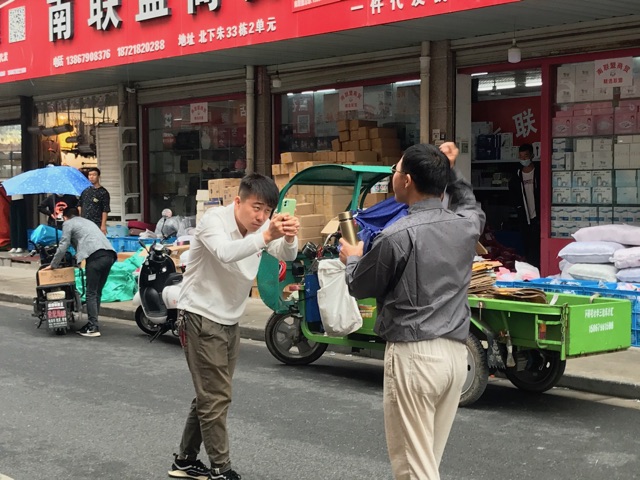How China’s livestream industry is revolutionizing ecommerce
The livestream industry is flourishing in China, with the top hosts gaining celebrity status and earning thousands per day off commissions. But becoming the next livestream star is not as easy as it seems.

As office workers are going home, that’s when Cherie, who just turned 30 last year, begins her day. At 7:30 p.m. sharp, she greets her audience in her livestream room on Alibaba’s retail marketplace Taobao. In a plain white shirt and slim blue jeans, she prepares some mix-and-match games. She puts on a beige handmade wool coat, the first product she is selling tonight, and poses for the camera. “This is made of premium wool from Inner Mongolia,” she says. “Now, type the hashtag #cashmerefestival and I will give out 20 coats for free.” The hashtag suddenly floods the screen. Fans love an engaging and generous livestreamer.
Cherie, whose real name is Zhū Chénhuì 朱宸慧, is a livestream host in China, someone who selects, showcases, and sells clothing and other products on her live show. With her southern accent, she strikes the figure of a “girl next door,” and is adored by her audience like a big sister. Over the next five hours, Cherie and her assistants try on more than 50 outfits and slip in three rounds of flash sales. Her voice gets hoarse past midnight, but she still manages to answer every question from the audience. At its peak, her viewership reaches 5 million.
Livestream shopping, initiated in China by ecommerce giants Alibaba and JD.com, flourished during the early days of the COVID-19 pandemic, which halted most businesses and forced consumers to stay home. Shoppers who grew tired of simply scrolling and clicking demanded a more interactive, entertaining, and immersive shopping experience. On livestream, people can watch, ask questions, chat with others, and shop, all at the same time.
The key to livestream shopping is a dynamic and engaging host. Cherie, along with the livestream queen Viya and “the lipstick king” Lǐ Jiāqí 李加琦, are the most celebrated livestreamers in China. Already a fashion influencer and owner of her own fashion brand, Chin, Cherie cultivated her fans into loyal customers. She recently celebrated her first anniversary of livestreaming and 10th anniversary in the fast-fashion industry. The sales queen livestreamed the event and turned the party into a live show, selling $47 million worth of merchandise in one night.
Thousands of people, of all different ages and backgrounds, have flocked to this industry in the past few years. But becoming the next Cherie isn’t as easy as it seems.
Amid paradise, a dog-eat-dog world
Hopefuls gather in Yiwu, Zhejiang province, known as the “factory of China” — or perhaps the world, as the city produces 80% of the world’s Christmas decorations, in addition to toys, jewelry, suitcases, and all kinds of small commodities. Donald Trump’s campaign signs came from Yiwu, too. In 2018, the city turned its eye toward the burgeoning livestreaming industry, and implemented a series of policies to support livestreamers. It currently hosts 5,000 livestreamers and 20,000 professionals in relevant industries.
Two miles south of downtown Yiwu is Beixiazhu, a village dedicated to the livestreaming business that has become the first stop for newcomers. A sign plastered over a wall in the entrance of the village reads: “China’s internet-famous livestreaming village. A paradise for entrepreneurs, Beixiazhu welcomes you.” And then there are the shops. An avenue down the hill is flanked by shops with flamboyant signs: shop names in bold characters against fiery-red backgrounds. They all bear the same word in addition to the names of the shops: bào kuǎn 爆款, which literally means a product (kuan) so popular that it bursts out (bao) and goes viral. They sell thermos, phone holders, incense burners, beauty products.
I step into a cosmetic shop, filled with facial masks and other beauty products. Two large boxes block the aisles, with more boxes on the steps outside. Naturally, the owner assumes I’m a livestreamer. “Which platform do you livestream on?” she asks. “How many followers do you have?”
Sixty-some identical five-story buildings are laid out in neat rows, like houses in Monopoly, with 10-meter-wide streets between them. Factory shops, offices of ecommerce companies, and low-price apartments have filled up this town, which is around the size of three soccer fields.
In front of a livestreaming “incubation center” that provides livestreamers with office space, I meet a young man here hoping to fulfill his livestream dream: Mǎ Kuān 马宽. In a black button-down shirt and black pants, he twirls a plastic phone holder — the latest bao kuan — in his hands.
The phone holder has two parts: an elastic clapper that grabs the phone and a backbone that can stand on the table. “It frees your hands when you cook or do other work. Someone I know sold 200,000 phone holders the other day via livestream,” Ma says.
Ma hails from Heilongjiang in China’s northmost, 800 miles away from Yiwu. The 23-year-old quit college after one year and has been in several businesses since. He has been to cities across China to chase business opportunities. Before arriving in Beixiazhu, Ma was in Beijing selling cosmetics, but it was China’s wholesale capital that called to him.
Livestreamers are salesmen in the age of ecommerce. Ma hosts his livestream show on Douyin, a short video platform (which outside China is called TikTok). On Douyin, anyone that registers with the local industrial and commercial bureau can open a “DouShop,” then hire livestreamers to promote their products. Customers in China are already spoiled by the kaleidoscopic array of cheap products on Taobao, but items on Douyin, directly supplied by factories, can be even cheaper. An incense burner is 9.99 yuan ($1.5), with free shipping.
Ma points at a girl with an eye-catching strawberry hairpin, squatting on a doorstep while talking on her phone. “That’s Lin, she earned 100,000 yuan ($15,500) commission the other day by selling incense burners.”
Ma spends his afternoon shooting videos for his livestreaming show, which airs at 7 p.m. With exaggerated expressions, he shouts loudly into his cell phone camera: “How much would you pay for this incense burner? Look at the craft, the fine patterns on the body of the burner. 39.9? 29.9? No, I offer you the price of 9.99 yuan today with free shipping! Come to my livestream show tonight at 7 p.m!”
With crowds walking in both directions, cars, scooters, and street vendors peddling lunch bentos, the video is loud and a bit vulgar. But, Ma explains, “Residents from low-tier cities and rural villages love these kinds of videos. They are the major buying power behind the frenzy.”
Ma’s show is unpolished and improvisational. On the other end of the production spectrum is Cherie, who has created for herself the image of an engaging, always glamorous, and trustworthy fashion icon. The truth is that she has a large team behind her, from supply chain, quality control, to copywriting and communications. She needs a continuous supply of high-quality products tailored to her audience: mostly female, ages 20 to 50 years old.
Cherie and Ma represent two classes of livestreamers in China: Cherie, along with a handful of livestreamers, are on the top of the pyramid — brands slash prices and raise commission fees in exchange for their endorsement — while thousands of small livestreamers, like Ma, stumble along the pyramid’s expansive bottom. Nearly 60% of livestream hosts leave the industry after less than a year, forced out by the fierce competition.
Ma is staring down just this dilemma. After three months in Beixiazhu, he has yet to make enough money to make ends meet. “Two of my acquaintances have quit and went back home,” Ma says. He is constantly confronting the question of when he himself might have to call it quits.
The next frontier
Livestreaming has grown so big and prosperous in China that being a livestream host is recognized by the government as an official occupation. Many local governments have launched one-month training sessions and tests to prepare livestreamers — many of whom would otherwise be classified as unskilled workers. According to a research report by Boss Hire, an online recruitment platform in China, more than 30% of livestreamers in China don’t have more than a high school degree.
Alibaba has set up a temporary livestream training center in a town in Zhejiang province, and plans to carry out similar programs in the future. Based on a syllabus shared by a Yiwu-based livestreaming school, the program is typically a four-day session that includes classes with titles such as “Shooting and editing short videos,” “How to attract fans on Douyin,” and “Livestreaming workshop.” Students sitting in cubicles screened off by glass partitions. Facing a ring lamp holding a phone in the middle, they promote a random product for 10 minutes at a time, while the instructor monitors their performance.
For novice and established livestreamers alike, there is one day for which they must apply all their training and effort: “Singles’ Day,” an online shopping festival on November 11, initiated by Alibaba and quickly embraced by all platforms. The event hauls in tens of billions of dollars for Chinese ecommerce companies every year.
In the days leading up to the most recent festival, Cherie’s team hosted 24 live shows with different themes in preparation for the 24-hour shopping frenzy on November 11. On the eve of the big day, they hosted a nine-hour live show, selling more than 90 products from her brands.
Her tireless work paid off: she was the Singles’ Day women’s clothes sales champion, outshining big corporations such as Zara and Uniqlo. Traditional fast-fashion leaders, offering only discounts without the personality, simply don’t impress shoppers anymore.
The growing popularity of livestreaming has allowed for more niche brands to flourish. Alice Fang, for example, manages a Taobao store that targets senior ladies over 60. She’s adapted to the ever-changing expectations of her customers. “At first, you only needed nicely shot pictures,” Fang says. “Then customers expected videos. Now, you not only need those, but also an interactive livestreaming show that details the quality of the outfits, and answers any questions the audience may have.”
Fang initially hired a slim young girl to be the brand’s livestreamer, but it didn’t work out. “She couldn’t pull off these loose-cut shirts and dresses specially designed for senior ladies,” Fang says. “And her face, glowing and smooth, without a wrinkle, just didn’t convince our customers to place orders.”
Now, a 50-year-old woman with a pair of two-inch heels runs the show. She works from 10 a.m. to 4 p.m. on weekdays, but on Singles’ Day, she does an extra shift, from 7 p.m. to midnight. “I don’t feel pressure from the younger hosts,” she says. “I don’t compare myself with them. I’m in this industry simply because I love fashion and the spotlight.” When an audience leaves a comment to say that she “looks as fit as a 30-year-old,” the host giggles and strikes two poses at the camera.
Meanwhile, livestreaming is racing into the next frontier: artificial intelligence. AI livestreamers — virtual personas that use computer-generated voices and 3D graphics — are now competing with humans. A short-hair cartoonish girl in a tank top promotes Three Squirrels, a domestic snack brand: “Make sure you add the snack you like into the shopping cart, we only have 400 left,” the AI livestreamer says in a robotic and flat voice.
With the help of the AI livestreamer, the company’s Singles’ Day sales topped a whopping $1.2 million. It’s enough to make everyone wonder whether the industry — for its human hosts — will contract as suddenly as it expanded.
When I reach out to Ma Kuan again after Singles’ Day, he seems disappointed. “In Beixiazhu, two out of three people you run into on the street are livestreamers,” he says. “The traffic is diluted. Without much of an audience coming to watch my show, I’m just muddling along now.”








